MITSUBISHI SPYDER 1990 Service Repair Manual
Manufacturer: MITSUBISHI, Model Year: 1990, Model line: SPYDER, Model: MITSUBISHI SPYDER 1990Pages: 2103, PDF Size: 68.98 MB
Page 1091 of 2103
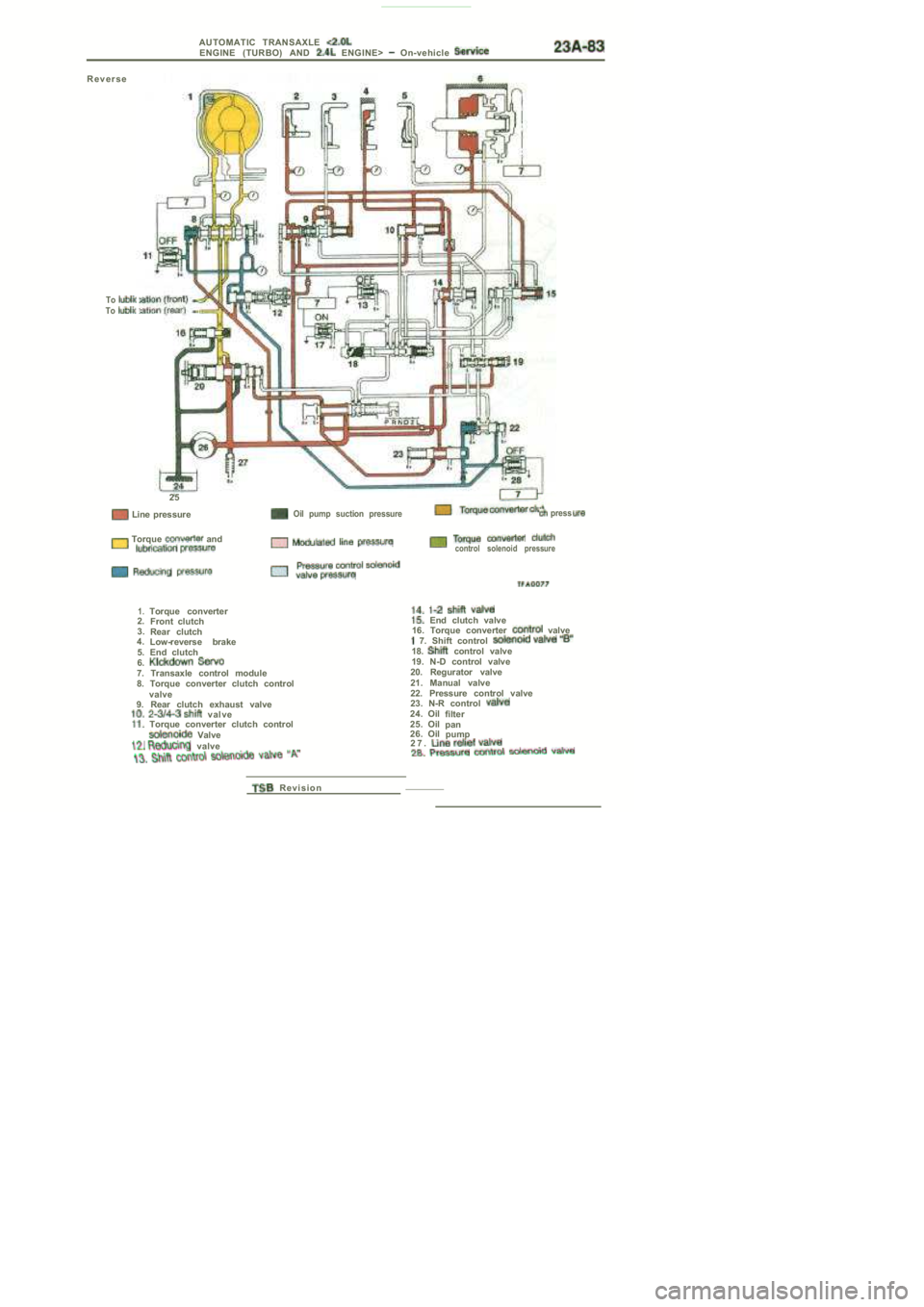
AUTOMATIC TRANSAXLE ENGINE (TURBO) AND ENGINE> On-vehicle
R e v e r s e
ToTo
25
Line pressure
Torque and
Oil pump suction pressure press
control solenoid pressure
1.Torque converter
2. Front clutch
3. Rear clutch
4. Low-reverse brake
5. End clutch
6.
7. Transaxle control module
8. Torque converter clutch control
valve
9. Rear clutch exhaust valve
v a l v e Torque converter clutch control Valve valve
R e v i s i o n
End clutch valve
16. Torque converter valve 7. Shift control 18. control valve
19. N-D control valve
20. Regurator valve
21. Manual valve
22. Pressure control valve
23. N-R control
24. Oil filter
25. Oil pan
26. Oil pump
2 7 .
Page 1092 of 2103

AUTOMATIC TRANSAXLE
ENGINE (TURBO) AND On-vehicle Service
Lock nut
SERVO ADJUSTMENT
1. Completely remove all dirt and other materials adhered
around the
servo switch.
2. Remove the snap ring.
3. Remove the
servo switch.
4. To prevent rotation of the piston, engage the
of
the special tool into the notch of the piston, and using
the adapter, secure the piston as shown to the left .
Caution
1Don’t press in the piston with the special tool.
2.When mounting the adapter on the transaxle case,
tighten it by hand. Do not overtighten.
5. Loosen the lock nut to before the V-groove of the adjusting
rod, and tighten the special tool (inner) until it contacts
the lock nut.
TSB Revision
Page 1093 of 2103
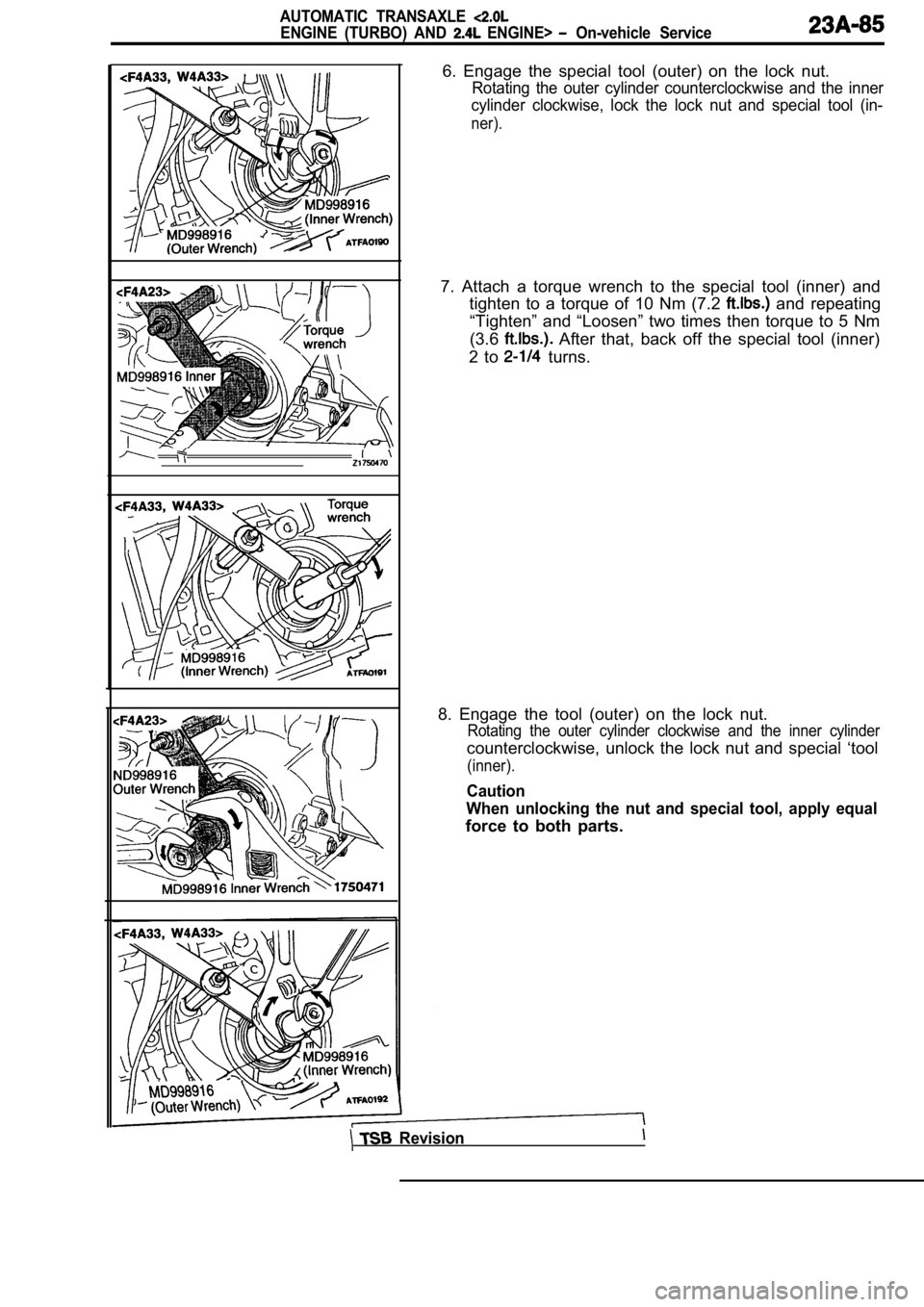
AUTOMATIC TRANSAXLE
ENGINE (TURBO) AND ENGINE> On-vehicle Service
6. Engage the special tool (outer) on the lock nut.
Rotating the outer cylinder counterclockwise and the inner
cylinder clockwise, lock the lock nut and special t ool (in-
ner).
7. Attach a torque wrench to the special tool (inne r) and
tighten to a torque of 10 Nm (7.2
and repeating
“Tighten” and “Loosen” two times then torque to 5 N m
(3.6
After that, back off the special tool (inner)
2 to
turns.
8. Engage the tool (outer) on the lock nut.
Rotating the outer cylinder clockwise and the inner cylinder
counterclockwise, unlock the lock nut and special ‘tool
(inner).
Caution
When unlocking the nut and special tool, apply equa l
force to both parts.
Revision
Page 1094 of 2103
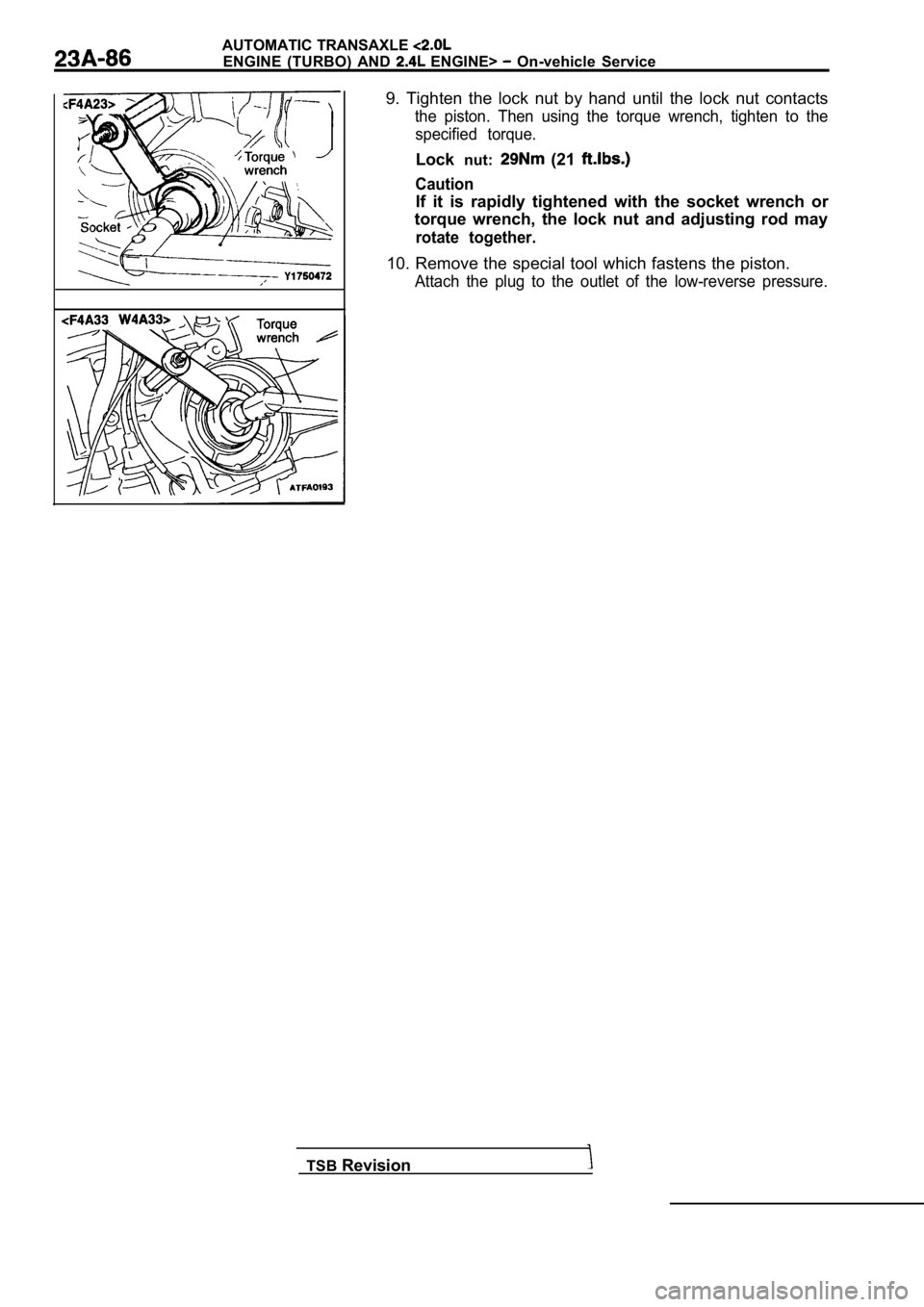
AUTOMATIC TRANSAXLE
ENGINE (TURBO) AND ENGINE> On-vehicle Service
9. Tighten the lock nut by hand until the lock nut contacts
the piston. Then using the torque wrench, tighten t o the
specified torque.
Lock nut: (21
Caution
If it is rapidly tightened with the socket wrench o r
torque wrench, the lock nut and adjusting rod may
rotate together.
10. Remove the special tool which fastens the pisto n.
Attach the plug to the outlet of the low-reverse pressure.
TSBRevision
Page 1095 of 2103
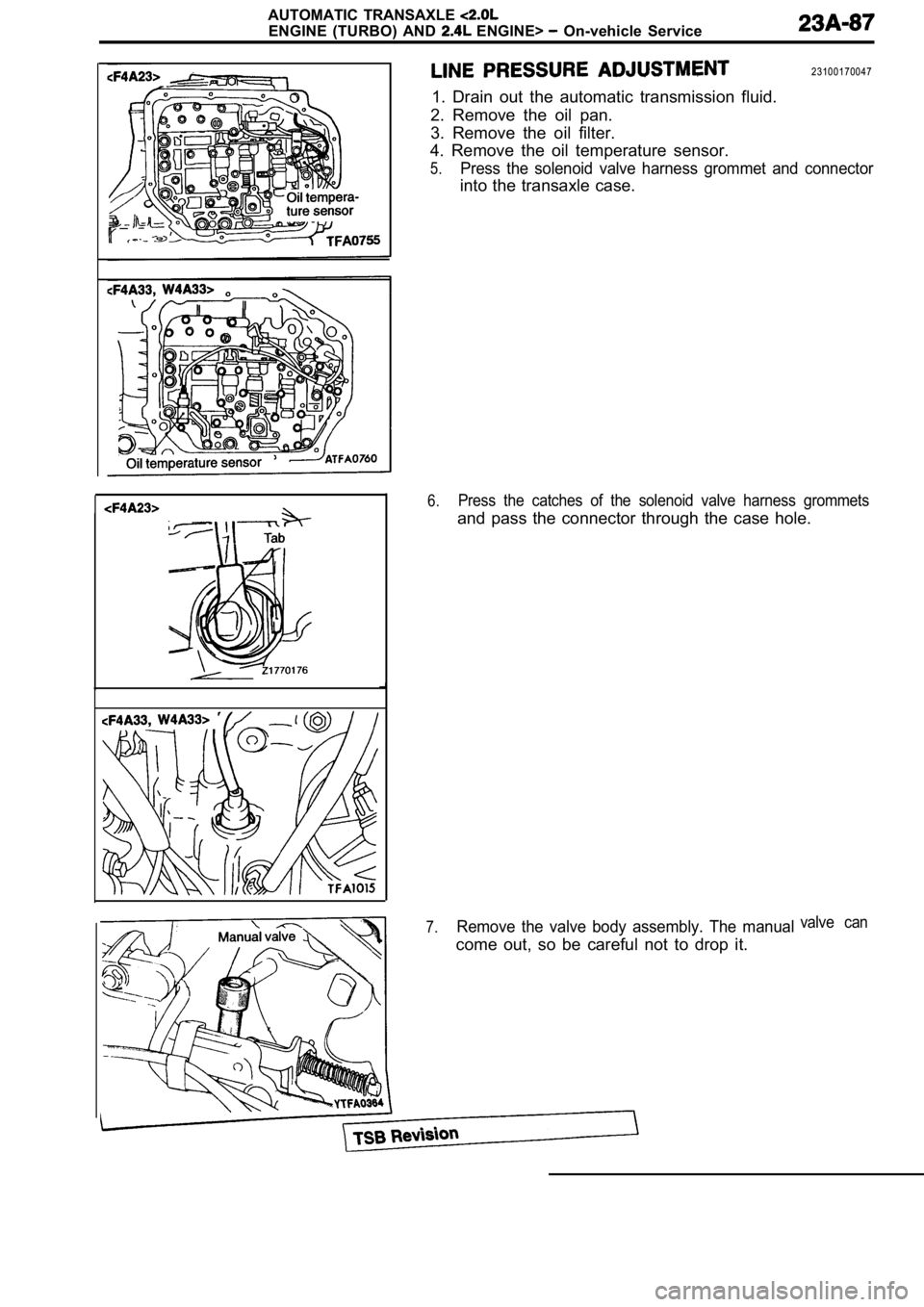
AUTOMATIC TRANSAXLE
ENGINE (TURBO) AND ENGINE> On-vehicle Service
23100170047
1. Drain out the automatic transmission fluid.
2. Remove the oil pan.
3. Remove the oil filter.
4. Remove the oil temperature sensor.
5.Press the solenoid valve harness grommet and connec tor
into the transaxle case.
6.Press the catches of the solenoid valve harness grommets
and pass the connector through the case hole.
7.Remove the valve body assembly. The manual
come out, so be careful not to drop it.
valve can
Page 1096 of 2103
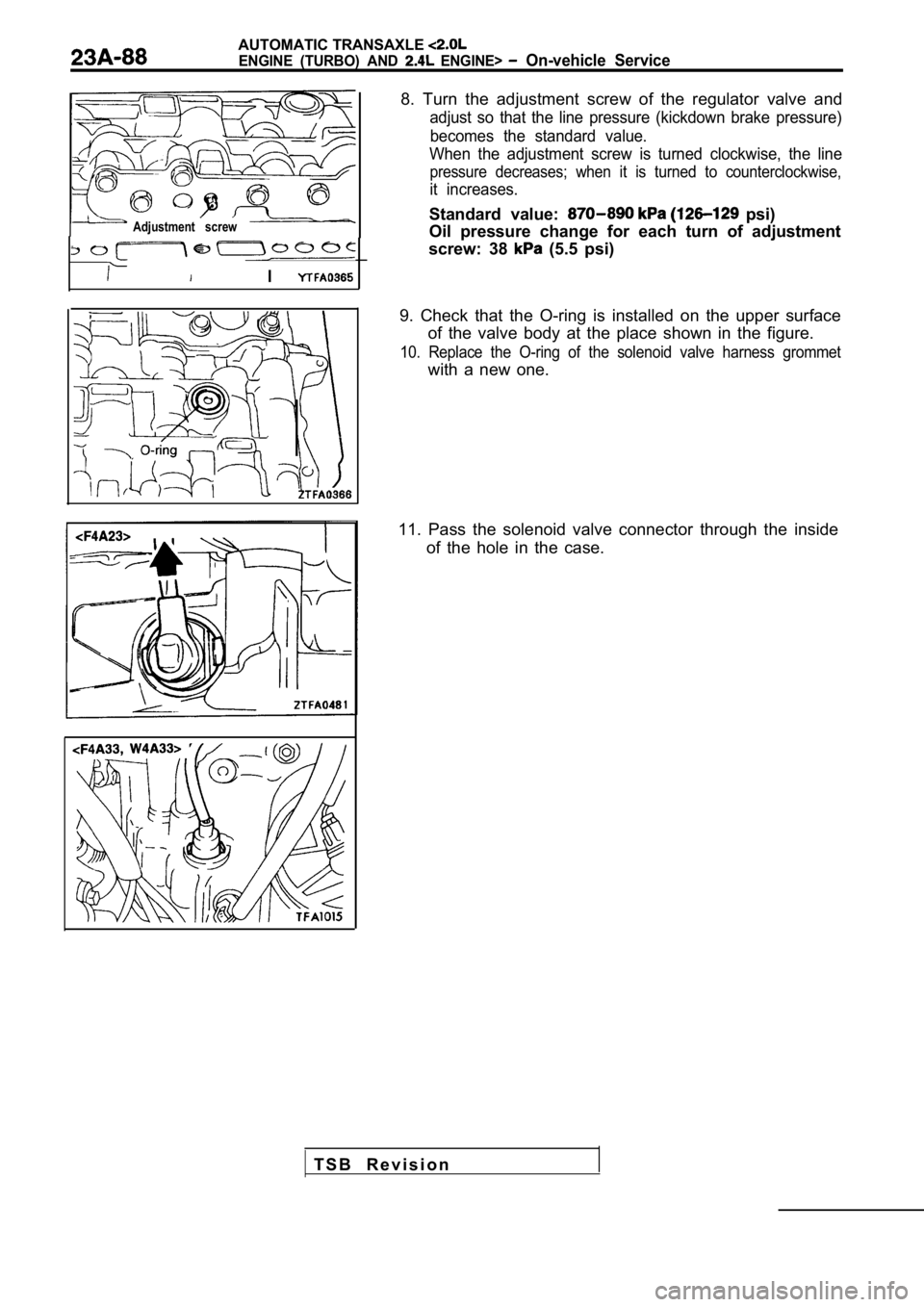
AUTOMATIC TRANSAXLE
ENGINE (TURBO) AND ENGINE> On-vehicle Service
Adjustment screw
I
8. Turn the adjustment screw of the regulator valve and
adjust so that the line pressure (kickdown brake pressure)
becomes the standard value.
When the adjustment screw is turned clockwise, the line
pressure decreases; when it is turned to counterclockwise,
it increases.
Standard value: psi)
Oil pressure change for each turn of adjustment
screw: 38
(5.5 psi)
9. Check that the O-ring is installed on the upper surface
of the valve body at the place shown in the figure.
10. Replace the O-ring of the solenoid valve harnes s grommet
with a new one.
11. Pass the solenoid valve connector through the i nside
of the hole in the case.
T S B R e v i s i o n
Page 1097 of 2103
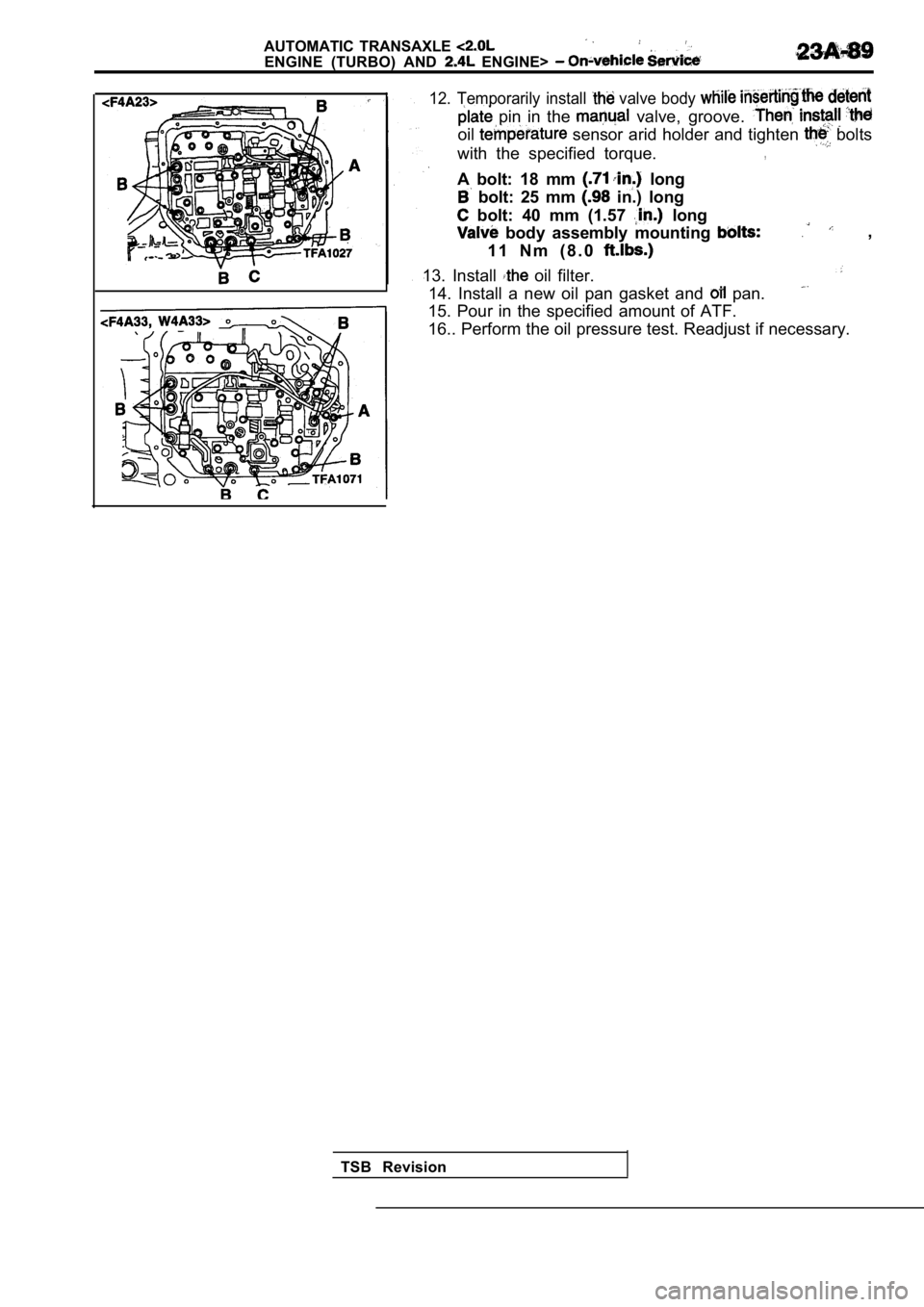
AUTOMATIC TRANSAXLE
ENGINE (TURBO) AND ENGINE>
12. Temporarily install valve body
pin in the valve, groove.
oil sensor arid holder and tighten bolts
with the specified torque.,
A bolt: 18 mm long
bolt: 25 mm in.) long
bolt: 40 mm (1.57 long
body assembly mounting ,
1 1 N m ( 8 . 0
13. Install oil filter.
14. Install a new oil pan gasket and pan.
15. Pour in the specified amount of ATF.
16.. Perform the oil pressure test. Readjust if nec essary.
TSB Revision
Page 1098 of 2103
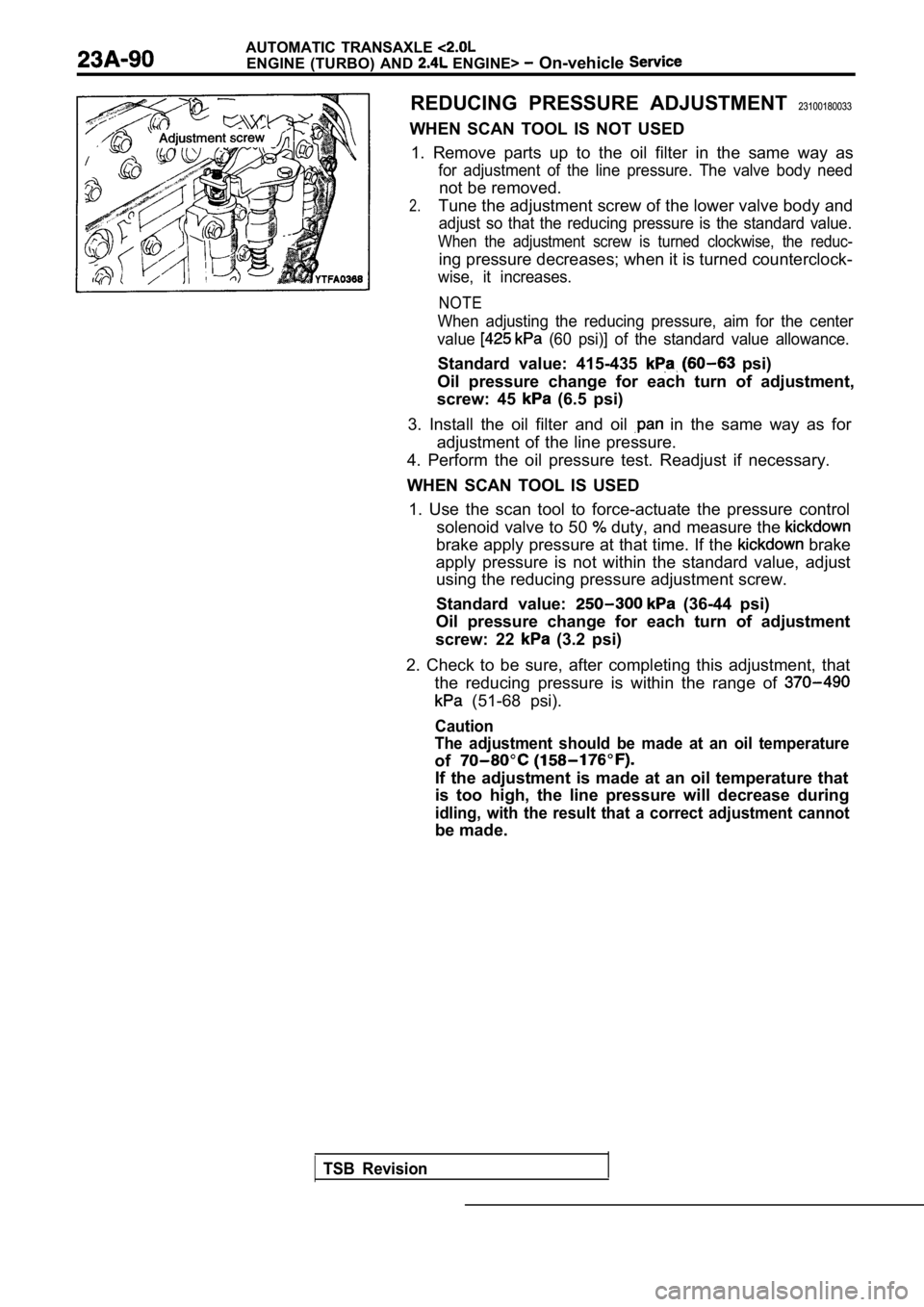
AUTOMATIC TRANSAXLE
ENGINE (TURBO) AND ENGINE> On-vehicle
REDUCING PRESSURE ADJUSTMENT 23100180033
WHEN SCAN TOOL IS NOT USED 1. Remove parts up to the oil filter in the same wa y as
for adjustment of the line pressure. The valve body need
not be removed.
2.Tune the adjustment screw of the lower valve body a nd
adjust so that the reducing pressure is the standard value.
When the adjustment screw is turned clockwise, the reduc-
ing pressure decreases; when it is turned counterclock-
wise, it increases.
NOTE
When adjusting the reducing pressure, aim for the c enter
value
(60 psi)] of the standard value allowance.
Standard value: 415-435 psi)
Oil pressure change for each turn of adjustment,
screw: 45
(6.5 psi)
3. Install the oil filter and oil
in the same way as for
adjustment of the line pressure.
4. Perform the oil pressure test. Readjust if neces sary.
WHEN SCAN TOOL IS USED 1. Use the scan tool to force-actuate the pressure control
solenoid valve to 50
duty, and measure the
brake apply pressure at that time. If the brake
apply pressure is not within the standard value, ad just
using the reducing pressure adjustment screw.
Standard value:
(36-44 psi)
Oil pressure change for each turn of adjustment
screw: 22
(3.2 psi)
2. Check to be sure, after completing this adjustme nt, that
the reducing pressure is within the range of
(51-68 psi).
Caution
The adjustment should be made at an oil temperature
of
If the adjustment is made at an oil temperature tha t
is too high, the line pressure will decrease during
idling, with the result that a correct adjustment c annot
be made.
TSB Revision
Page 1099 of 2103
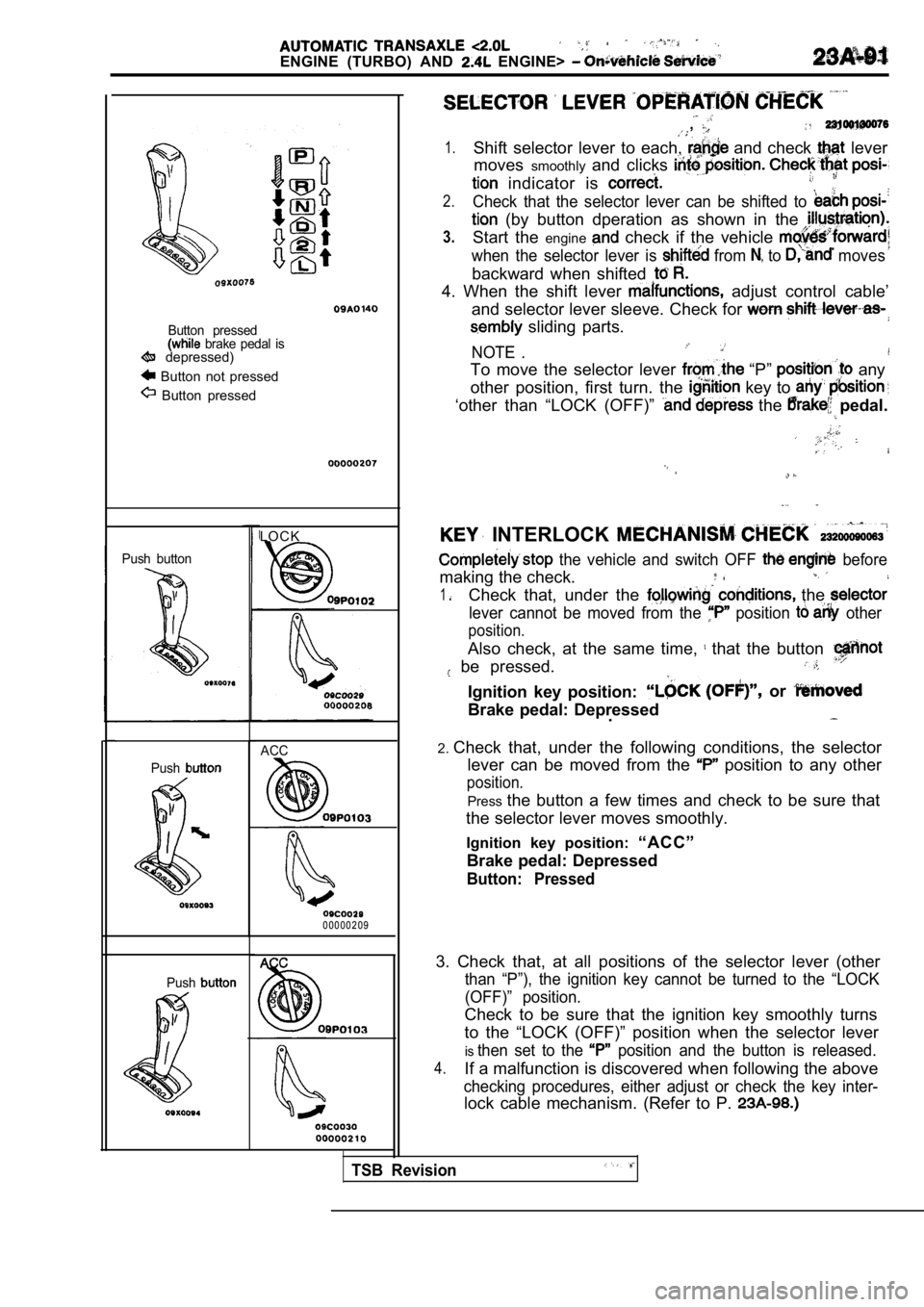
ENGINE (TURBO) AND ENGINE>
Button pressed brake pedal is depressed)
Button not pressed
Button pressed
Push buttonPush
Push
LOCK
ACC
0 0 0 0 0 2 0 9
,
1.Shift selector lever to each, and check lever
moves smoothly and clicks
indicator is
2.Check that the selector lever can be shifted to
(by button dperation as shown in the
3.Start the engine check if the vehicle
when the selector lever is from to moves
backward when shifted
4. When the shift lever adjust control cable’
and selector lever sleeve. Check for
sliding parts.
NOTE .
To move the selector lever “P” any
other position, first turn. the
key to
‘other than “LOCK (OFF)” the pedal.
. .
INTERLOCK
the vehicle and switch OFF before
making the check.
1Check that, under the the
lever cannot be moved from the position other
position.
Also check, at the same time, that the button
be pressed.
Ignition key position: or
Brake pedal: Depressed .
2.Check that, under the following conditions, the sel ector
lever can be moved from the
position to any other
position.
Press the button a few times and check to be sure that
the selector lever moves smoothly.
Ignition key position: “ACC”
Brake pedal: Depressed
Button: Pressed
TSB Revision
3. Check that, at all positions of the selector lev er (other
than “P”), the ignition key cannot be turned to the “LOCK
(OFF)” position.
Check to be sure that the ignition key smoothly tur ns
to the “LOCK (OFF)” position when the selector leve r
isthen set to the position and the button is released.
4.If a malfunction is discovered when following the above
checking procedures, either adjust or check the key inter-
lock cable mechanism. (Refer to P.
Page 1100 of 2103
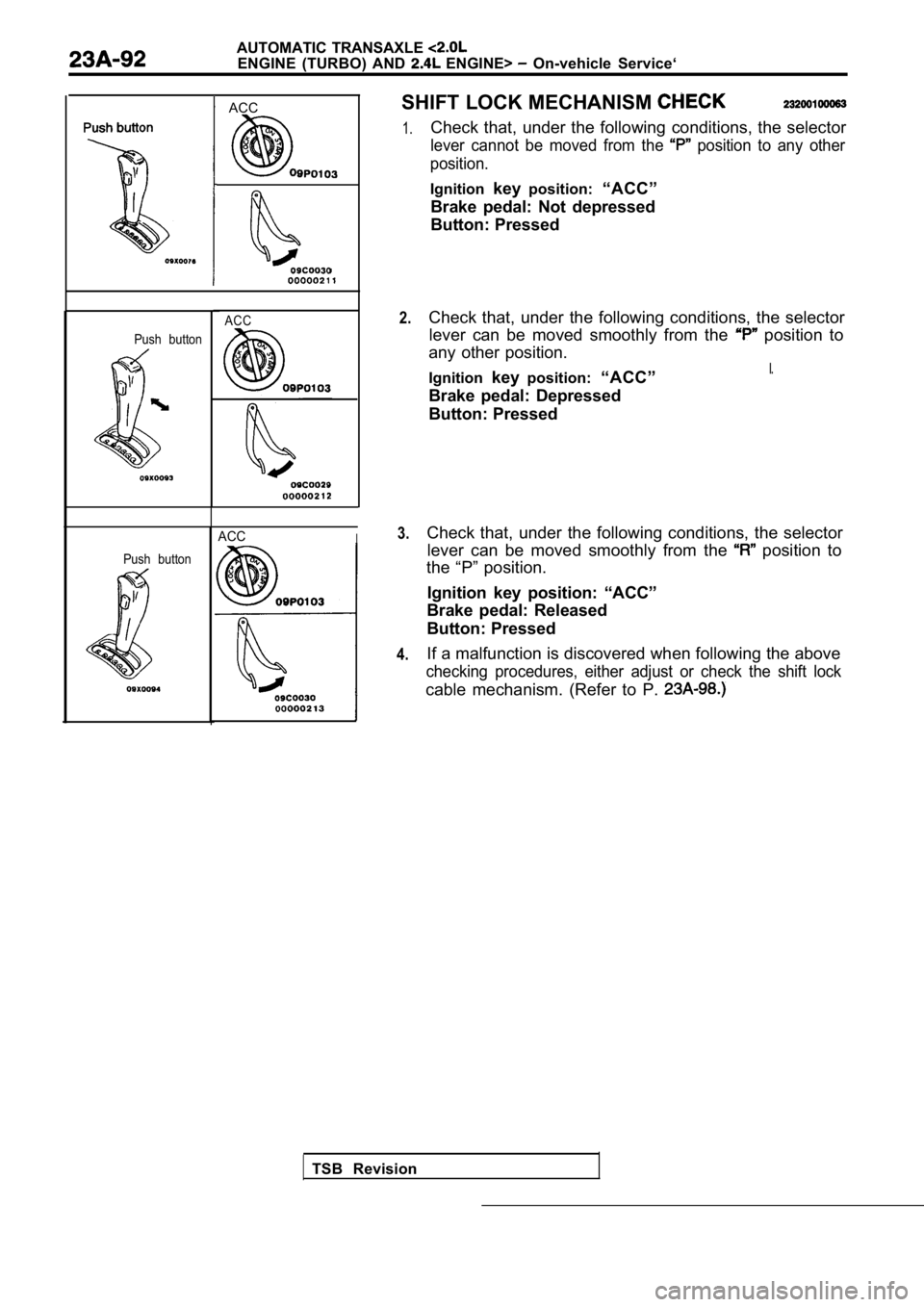
AUTOMATIC TRANSAXLE
ENGINE (TURBO) AND ENGINE> On-vehicle Service‘
ACCSHIFT LOCK MECHANISM
1.
2.
3.
4.
Push button
Push button ACC
ACCI
TSB Revision Check that, under the following conditions, the sel
ector
lever cannot be moved from the position to any other
position.
Ignition keyposition: “ACC”
Brake pedal: Not depressed
Button: Pressed
Check that, under the following conditions, the sel ector
lever can be moved smoothly from the
position to
any other position.
Ignition keyposition: “ACC”
Brake pedal: Depressed
Button: Pressed
I.
Check that, under the following conditions, the sel ector
lever can be moved smoothly from the
position to
the “P” position.
Ignition key position: “ACC”
Brake pedal: Released
Button: Pressed
If a malfunction is discovered when following the a bove
checking procedures, either adjust or check the shi ft lock
cable mechanism. (Refer to P.